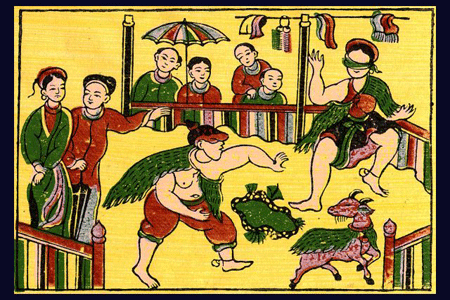Folk paintings are a combination of traditional cultural values with ancient artistic methods that have been created through the labour of past generations. There are two types of Vietnamese folk paintings, Tet (Lunar New Year Festival) paintings and worshipping paintings.

The Vietnamese believe in ancestor worship and the deification of natural phenomena, both of which are reflected in the paintings.
Due to their historical popularity, the folk paintings were produced in large quantities. This high demand was met through the use of the woodblock carving printing technique, which has been practiced by the Vietnamese for many centuries. During the Ly Dynasty (12th century), there were many families who specialised in woodblock carving. By the end of the Tran Dynasty, they were also printing paper money. At the beginning of the Le So Dynasty, the Chinese technique of carving printing boards was adopted and improved. The History Museum and the Fine Art Museum in Ha Noi still keep old printing boards as archives.
During the Mac Dynasty (16th century), folk paintings developed quite extensively and were popular among the aristocracy in Thang Long. In the 18th and 19th centuries, the art of folk painting was stable and highly developed.
Depending on artistic style, drawing-printing technique, and the materials used, folk paintings are classified into painting trends according to the name of their place of production.
Each style of painting is different. However, in all the styles, shapes are created based on the concept of don tuyen binh do (single line-simple designs), which uses lines to bend the coloured shapes and to make a border for the picture. Another method used is thuan tay hay mat (easy to draw and to see). With this design form, the folk paintings do not depend on the rules of perspective. The deities are large and take the upper positions, while the ordinary people are drawn on a smaller scale and the size of the animals and the natural scenery depicted depends on their relationship to the sentiment or story being expressed. These unique characteristics make the paintings profoundly impressive.
As a result of cultural exchange, Vietnamese folk paintings have retained and developed certain traditional aspects. As well, the paintings have been influenced and enriched by the genius of other painting styles. One exception is Dong Ho paintings, which continue to exist unchanged against the challenges of time.
Dong Ho Paintings

These paintings which originated in the Red River Delta, are the most famous. The artists coat do paper (the Rhamnoneuron paper) with diep powder (a white powder made from the shells of diep, a kind of fluvial bivalve mollusk) to make silver lustre glitter. Sometimes yellow flower powder called Hoa hoe or orange-red sapandwood powder is used to make the colours more elegant and shiny.
On that background, the colours are applied with a woodblock. Some of the paintings only have simple black lines, while others are printed with one other colour. All of the materials for creating the colours for these paintings come from nature. A wide spectrum of colours can be made using mixing and multi-coloured printing techniques.
Dong Ho paintings reflect people’s innermost feelings, wishes, and simple dreams. Because the paintings appeal to so many people, they are available throughout the country, from the village markets to the capital city.
Hang Trong Paintings

Hang Trong paintings are also printed with black lines to form the basis for the colour. But, unlike Dong Ho paintings, they are made by hand. Large sheets of imported paper and brightly coloured paints are used for Hang Trong paintings. The content of these paintings are very much influenced by Chinese drawings.
Hang Trong paintings are popular as worshipping paintings in temples. As such, the paintings are often hung in spacious living rooms or in holy places.
Hang Trong paintings have traditionally served the poorer classes and are made and sold in the capital city.
Kim Hoang Paintings

Kim Hoang paintings, which are often called red paintings, are made on the outskirts of ancient Thang Long. Kim Hoang paintings are printed and drawn on imported coloured paper (yellow, bright red, pink) and printed with black lines and shapes; other colours used to separate the shapes.
The colours are applied in rough, but flexible lines. Sometimes, the paintings are reprinted to create clear line. The colours used for Kim Hoang paintings are bought and then mixed by the painters, except for indigo, which is self-processed. The themes of Kim Hoang paintings are similar to those of the Dong Ho paintings, but there are also Chinese character paintings Phuc, Loc, Tho (meaning “Happiness”, “Good Luck”, and “Longevity” respectively), that have the typical flower of each season printed next to each character.
Sinh Village Paintings

Sinh Village Paintings, which come from Sinh Village, a suburb of Hue City, are well-known in the central region of Viet Nam. Most Sinh Village paintings are used for worship, and they express the mystical, nature-based beliefs of the ancient Vietnamese.
Among these pictures is the Tuong Ba (Statue of the Lady) painting, the guardian angel of women. Sinh paintings are made using just one printing-board to create the drawing lines and black shapes. After being printed in black, the work is sometimes completed with embellishments made with colourful lines. Some paintings are still printed on rustic paper.